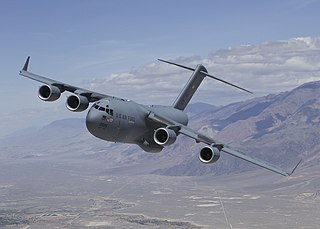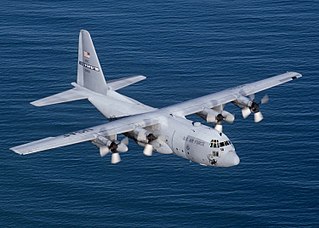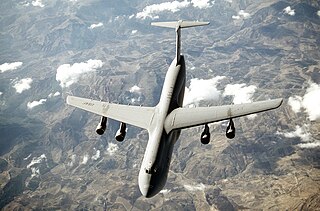Related Research Articles

The McDonnell Douglas/Boeing C-17 Globemaster III is a large military transport aircraft that was developed for the United States Air Force (USAF) from the 1980s to the early 1990s by McDonnell Douglas. The C-17 carries forward the name of two previous piston-engined military cargo aircraft, the Douglas C-74 Globemaster and the Douglas C-124 Globemaster II.

The Lockheed C-130 Hercules is an American four-engine turboprop military transport aircraft designed and built by Lockheed. Capable of using unprepared runways for takeoffs and landings, the C-130 was originally designed as a troop, medevac, and cargo transport aircraft. The versatile airframe has found uses in other roles, including as a gunship (AC-130), for airborne assault, search and rescue, scientific research support, weather reconnaissance, aerial refueling, maritime patrol, and aerial firefighting. It is now the main tactical airlifter for many military forces worldwide. More than 40 variants of the Hercules, including civilian versions marketed as the Lockheed L-100, operate in more than 60 nations.

The Lockheed C-5 Galaxy is a large military transport aircraft designed and built by Lockheed, and now maintained and upgraded by its successor, Lockheed Martin. It provides the United States Air Force (USAF) with a heavy intercontinental-range strategic airlift capability, one that can carry outsized and oversized loads, including all air-certifiable cargo. The Galaxy has many similarities to the smaller Lockheed C-141 Starlifter and the later Boeing C-17 Globemaster III. The C-5 is among the largest military aircraft in the world.

The McDonnell Douglas C-9 is a retired military version of the McDonnell Douglas DC-9 airliner. It was produced as the C-9A Nightingale for the United States Air Force, and the C-9B Skytrain II for the U.S. Navy and Marine Corps. The final flight of the C-9A Nightingale was in September 2005, and the C-9C was retired in September 2011. The U.S. Navy retired its last C-9B in July 2014. The two remaining C-9s in Marine service were retired in April 2017.

The Boeing C-40 Clipper is a military version of the Boeing 737 Next Generation used to transport cargo and passengers. It is used by the United States Navy, Air Force, and Marine Corps. The Navy C-40A variant is named "Clipper", whereas the USAF C-40B/C variants are officially unnamed.

The Douglas C-47 Skytrain or Dakota is a military transport aircraft developed from the civilian Douglas DC-3 airliner. It was used extensively by the Allies during World War II. During the war the C-47 was used for troop transport, cargo, paratrooper, for towing gliders and military cargo parachute drops. The C-47 remained in front-line service with various military operators for many years. It was produced in approximately triple the numbers as the larger, much heavier payload Curtiss C-46 Commando, which filled a similar role for the U.S. military.

The Boeing T-43 is a retired modified Boeing 737-200 that was used by the United States Air Force for training navigators, now known as USAF combat systems officers, from 1973 to 2010. Informally referred to as the Gator and "Flying Classroom", nineteen of these aircraft were delivered to the Air Training Command (ATC) at Mather Air Force Base, California during 1973 and 1974. Two additional aircraft were delivered to the Colorado Air National Guard at Buckley Air National Guard Base and Peterson Air Force Base, Colorado, in direct support of cadet air navigation training at the nearby U.S. Air Force Academy. Two T-43s were later converted to CT-43As in the early 1990s and transferred to Air Mobility Command (AMC) and United States Air Forces in Europe (USAFE), respectively, as executive transports. A third aircraft was also transferred to Air Force Materiel Command (AFMC) for use as the "Rat 55" radar test bed aircraft and was redesignated as an NT-43A. The T-43A was retired by the Air Education and Training Command (AETC) in 2010 after 37 years of service.

The Douglas C-54 Skymaster is a four-engined transport aircraft used by the United States Army Air Forces in World War II and the Korean War. Like the Douglas C-47 Skytrain derived from the DC-3, the C-54 Skymaster was derived from a civilian airliner, the Douglas DC-4. Besides transport of cargo, the C-54 also carried presidents, prime ministers, and military staff. Dozens of variants of the C-54 were employed in a wide variety of non-combat roles such as air-sea rescue, scientific and military research, and missile tracking and recovery. During the Berlin Airlift it hauled coal and food supplies to West Berlin. After the Korean War it continued to be used for military and civilian uses by more than 30 countries. It was one of the first aircraft to carry the President of the United States, the first being President Franklin D. Roosevelt during World War II.

The Douglas C-124 Globemaster II, nicknamed "Old Shaky", is an American heavy-lift cargo aircraft built by the Douglas Aircraft Company in Long Beach, California.

The Douglas C-133 Cargomaster is an American large turboprop cargo aircraft built between 1956 and 1961 by the Douglas Aircraft Company for use with the United States Air Force. The C-133 was the USAF's only production turboprop-powered strategic airlifter, entering service shortly after the Lockheed C-130 Hercules, which is designated a tactical airlifter. It provided airlift services in a wide range of applications, being replaced by the C-5 Galaxy in the early 1970s.

The Boeing C-97 Stratofreighter was a long-range heavy military cargo aircraft developed from the B-29 and B-50 bombers. Design work began in 1942, the first of three prototype XC-97s flew on 9 November 1944 and the first of six service-test YC-97s flew on 11 March 1947. All nine were based on the 24ST alloy structure and Wright R-3350 engines of the B-29, but with a larger-diameter fuselage upper lobe and they had the B-29 vertical tail with the gunner's position blanked off. The first of three heavily revised YC-97A incorporating the re-engineered wing, taller vertical tail and larger Pratt & Whitney R-4360 engines of the B-50 bomber, flew on 28 January 1948 and was the basis of the subsequent sole YC-97B, all production C-97s, KC-97s and civilian Stratocruiser aircraft. Between 1944 and 1958, 888 C-97s in several versions were built, 811 being KC-97 tankers. C-97s served in the Berlin Airlift, the Korean War, and the Vietnam War. Some aircraft served as flying command posts for the Strategic Air Command, while others were modified for use in Aerospace Rescue and Recovery Squadrons (ARRS).

The Boeing C-135 Stratolifter is a transport aircraft derived from the prototype Boeing 367-80 jet airliner in the early 1950s. It has a narrower fuselage and is shorter than the 707. Boeing gave the aircraft the internal designation of Model 717. Since the first one was built in August 1956, the C-135 and its variants have been a fixture of the United States Air Force.

The McDonnell Douglas YC-15 is a replaced prototype four-engine short take-off and landing (STOL) tactical transport. It was McDonnell Douglas' entrant into the United States Air Force's Advanced Medium STOL Transport (AMST) competition to replace the Lockheed C-130 Hercules as the USAF's standard STOL tactical transport. In the end, neither the YC-15 nor the Boeing YC-14 was ordered into production, although the YC-15's basic design would be used to form the successful McDonnell Douglas C-17 Globemaster III.

The Advanced Medium STOL Transport (AMST) project was intended to replace the Lockheed C-130 Hercules tactical transport in United States Air Force service with a new aircraft with improved STOL performance. Increased need for strategic airlift led the Air Force to cancel the AMST program and seek a larger airlifter. Under the C-X program, the YC-15's basic design would become the successful McDonnell Douglas C-17 Globemaster III.

The Lockheed C-141 Starlifter is a retired military strategic airlifter that served with the Military Air Transport Service (MATS), its successor organization the Military Airlift Command (MAC), and finally the Air Mobility Command (AMC) of the United States Air Force (USAF). The aircraft also served with airlift and air mobility wings of the Air Force Reserve (AFRES), later renamed Air Force Reserve Command (AFRC), the Air National Guard (ANG) and, later, one air mobility wing of the Air Education and Training Command (AETC) dedicated to C-141, C-5, C-17 and KC-135 training.

The Douglas C-132 was an American military transport aircraft proposed in the 1950s by the Douglas Aircraft Company, based on the company's C-124 Globemaster II. The C-132 would have been the largest aircraft of its era.

The 21st Airlift Squadron is part of the 60th Air Mobility Wing at Travis Air Force Base, California. It operates C-17 Globemaster III aircraft carrying out United States Air Force global transport missions, duties which involve airlift and airdrop missions as well as provision of services and support in order to promote quality of life for both soldiers and civilians in situations requiring humanitarian aid.

The Lockheed C-121 Constellation is a military transport version of the Lockheed Constellation. A total of 332 aircraft were constructed for both the United States Air Force and United States Navy for various purposes. Numerous airborne early warning versions were also constructed. The C-121 later saw service with smaller civilian operators until 1993.

The Boeing C-137 Stratoliner is a retired VIP transport aircraft derived from the Boeing 707 jet airliner used by the United States Air Force. Other nations also bought both new and used 707s for military service, primarily as VIP or tanker transports. In addition, the 707 served as the basis for several specialized versions, such as the E-3 Sentry AWACS aircraft. The designation C-18 covers several later variants based on the 707-320B/C series. The C-137 should not be confused with the similar Boeing C-135 Stratolifter; although they share a common ancestor the two aircraft have different fuselages, among other structural differences.

The Lockheed L-1249 Super Constellation was a turboprop-powered version of the Lockheed Constellation aircraft family. Built in 1954 and 1955, the aircraft were used as prototypes for possible future military transport aircraft for both the United States Air Force and United States Navy. Both aircraft saw very short lives and the airframes were later used to build L-1049 Super Constellations.
References
- 1 2 3 Cox, George, and Kaston, Craig, 2019. American Secret Projects 2: Airlifters 1941-1961. Manchester: Crecy Publishing.
- ↑ Holder and Vadnais, 2004. The "C" Planes: U.S. Cargo Aircraft from 1925 to the Present. Atglen, PA: Schiffer Publishing.
- 1 2 Johnson, E.R.; Jones, Lloyd S. (2013). American military transport aircraft since 1925. McFarland & Company, Inc.
- James C. Fahey (1978). USAF Aircraft 1947-1956. Air Force Museum Foundation.